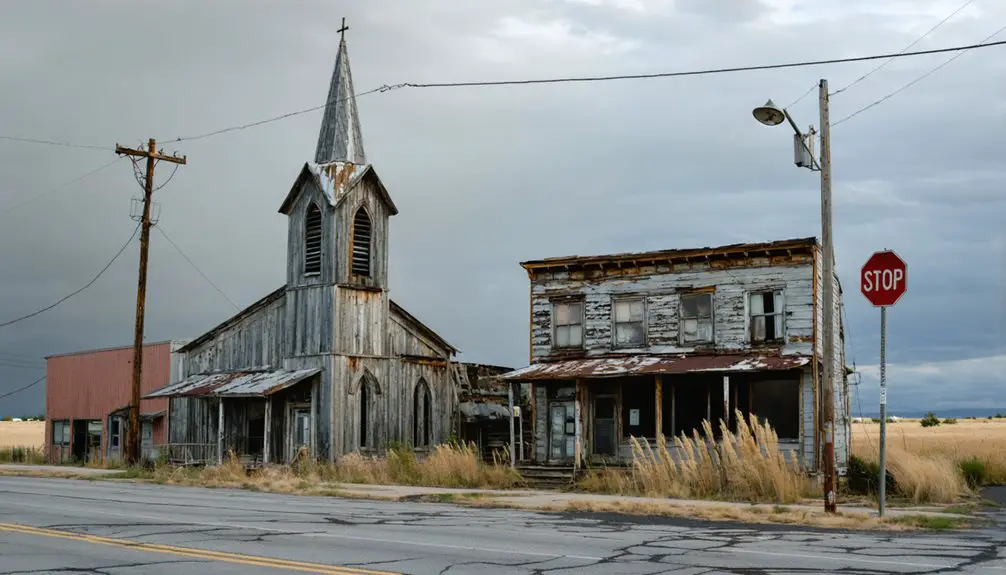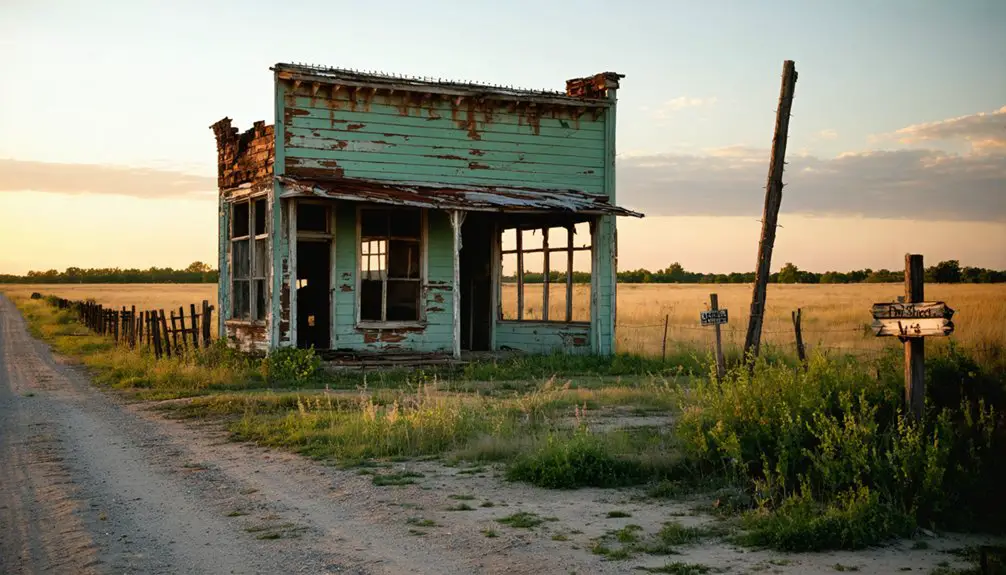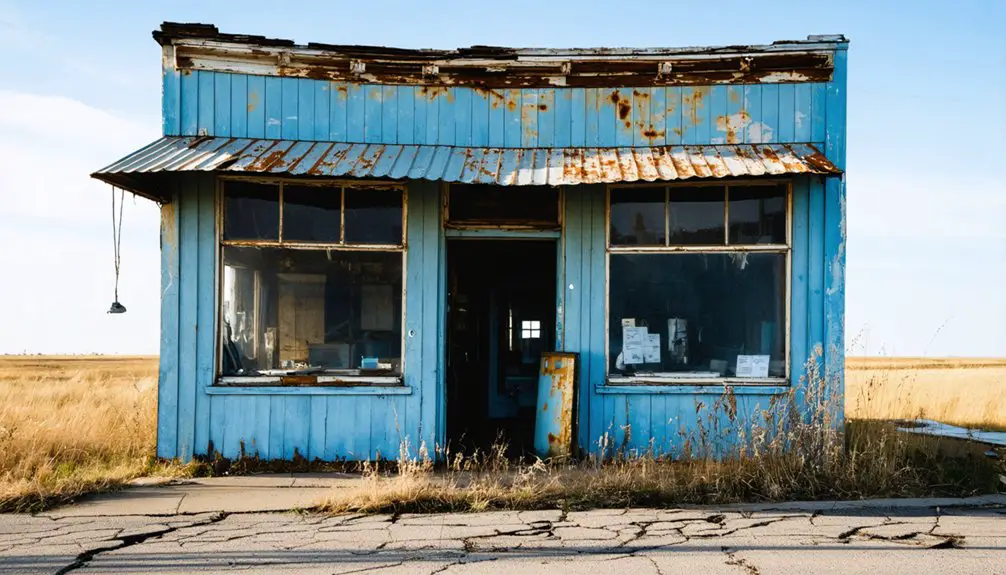You’ll find Paw Paw, Oklahoma about seven miles southeast of Muldrow in Sequoyah County. Founded in 1882, this once-thriving riverside settlement centered around a general store, post office, and blacksmith shop, with ferry service to Fort Smith. While pioneer families initially prospered through agriculture and trade, the town declined after a devastating steamboat accident disrupted transportation networks. Today, scattered foundations, toxic chat piles, and a handful of isolated homes mark this ghost town’s haunting legacy.
Key Takeaways
- Founded in 1882 near the Arkansas River, Paw Paw thrived as an agricultural community with essential services like stores and ferries.
- The town’s decline began after a devastating steamboat accident disrupted vital transportation links to Fort Smith and other markets.
- Severe lead and zinc contamination from mining waste now restricts access, with 110 million tons of toxic chat piles remaining.
- Only scattered foundations, deteriorating storefronts, and a few inhabited homes remain of the once-bustling agricultural community.
- Located seven miles southeast of Muldrow in Sequoyah County, the site requires careful navigation and local permission to visit.
The Birth of a Frontier Settlement (1882)
Three key factors drove the establishment of Paw Paw, Oklahoma in 1882: its strategic location along the Arkansas River, the region’s fertile soil, and its connection to the Civil War-era Paw Paw Society.
The birth of Paw Paw in 1882 stemmed from its riverside location, rich farmland, and historic ties to the Paw Paw Society.
You’ll find that early settlers faced significant settlement challenges as they cleared the land, but they were drawn by promising agricultural prospects in the river bottomlands. The Dhegiha-speaking people had inhabited this region long before European settlement, having migrated from the Ohio River valley after 1200 CE.
The community quickly developed around essential services, with a general store, post office, and blacksmith shop forming the heart of the settlement.
Governor Watts, who owned the store and substantial riverfront property, emerged as a prominent local leader.
The river proved vital to Paw Paw’s early success, as steamboats regularly connected the frontier outpost to major markets in Little Rock and Muskogee, enabling trade and agricultural exports.
Life in Early Paw Paw
You’d find early Paw Paw bustling with activity around its essential blacksmith shop and general store, where residents gathered not just for commerce but to exchange news and maintain community bonds.
The ferry service played a central role in daily life, with its structured fare system facilitating the transport of agricultural goods, livestock, and people to Fort Smith markets despite challenging road conditions.
Pioneer families like the Watts, Pattons, and Claborns worked cooperatively to establish a self-sufficient community, sharing resources and labor to overcome the settlement’s geographic isolation. Similar to the later tribal capital settlement, Paw Paw served as an important gathering place for early Oklahoma pioneers. Like many settlers who faced severe dust storms during the 1930s, the community struggled to maintain agricultural production.
Daily Frontier Settlement Life
Life in early Paw Paw centered around essential frontier establishments, including a bustling general store with an integrated post office and an important blacksmith shop. Some settlers cultivated local Pawpaw trees as a reliable food source.
You’d find pioneer agriculture at the heart of daily activities, with farmers like Marion J. Watts and Lindsey Dickey working the land for both subsistence and market sales. Winter wheat became increasingly important to local farmers, following broader county trends that saw dramatic acreage increases over the decades.
River transportation proved critical to your survival, as you’d rely on the ferry system to cross the swift waters. For 40 cents round trip, you could transport your wagon loaded with produce to market, while horseback crossing cost just 10 cents.
Though the rope-and-pulley ferry system faced occasional mechanical issues, it served as your lifeline, carrying mail, newspapers, and up to three wagons at once across the challenging terrain.
Local Trade and Commerce
While the general store and blacksmith shop formed Paw Paw’s commercial backbone, trade networks largely depended on the ferry system to connect local farmers with external markets.
You’d pay 40 cents to cross with your wagon, allowing you to transport produce, pawpaw fruit, and other agricultural goods to Fort Smith’s bustling markets. Local farmers found pawpaw fruit particularly valuable since it was a dietary staple that Indigenous peoples had relied on for thousands of years.
Trade barriers were significant – you’d face poor roads on the Paw Paw side that turned impassable in wet weather, and the ferry’s rope-pulley system sometimes failed, stranding cargo downstream.
Agricultural exchanges centered around pioneer families like the Watts, Patton, and Cherry clans, who relied on the ferry despite its challenges. Like the successful Million Dollar Elm auctions that would later define commerce in Pawhuska, these early trading posts were vital meeting places for business transactions.
The general store, doubling as your post office, served as the hub where you’d conduct business, exchange news, and gather supplies essential for frontier survival.
Community Social Activities
Despite its remote location, early Paw Paw’s social life centered around three key gathering spots – the general store-post office, the ferry crossing, and pioneer family homes.
You’d find locals catching up on news while collecting mail or waiting for ferry crossings, where the fare structure – 40 cents for wagons, 10 cents for horseback, and 5 cents for walking – made regular social interactions possible.
Community folklore grew from shared experiences, like dramatic tales of ferry ropes breaking and boats drifting downstream.
Pioneer families like the Watts, Pattons, and Claborns fostered social gatherings through kinship networks, often hosting celebrations and religious meetings in their homes.
Even practical activities at the blacksmith shop became opportunities for conversation and mutual support, weaving together the fabric of Paw Paw’s tight-knit community.
The area’s cultural dynamics were shaped by the interaction between legal residents and illegal resident intrusion, creating a unique social atmosphere in the settlement.
Economic Activities and Local Development
Throughout its brief history, Paw Paw’s economy centered primarily on agricultural production, with cotton and corn serving as the main crops for local farmers. The economic viability of these farming operations faced significant market challenges, with farmers often struggling to cover basic expenses. Like much of Oklahoma in the early 1900s, Paw Paw reflected the state’s high ratio of land compared to available labor and capital resources. Unlike the lead and zinc mining that brought prosperity to towns like Picher in the 1920s, Paw Paw remained largely disconnected from broader economic development, ultimately contributing to its decline.
If you’d visited Paw Paw during its peak, you’d have encountered:
- A rope-and-pulley ferry system charging 40 cents for wagon crossings, essential for transporting goods to Fort Smith.
- Pioneer families like Marion J. Watts and R.B. Patton working to develop the isolated community.
- Muddy, nearly impassable roads that severely limited market access during wet weather.
- Small-scale subsistence farming operations with minimal profit margins.
Unlike other Oklahoma towns that benefited from railroads and resource extraction, Paw Paw remained largely disconnected from broader economic development, ultimately contributing to its decline.
The Road to Abandonment

After decades of precarious existence, Paw Paw’s decline accelerated sharply when a devastating steamboat accident at Fort Smith’s railroad bridge severed the town’s fundamental transportation lifeline.
You’ll find that this incident marked a significant turning point, as the town’s isolation deepened when it couldn’t adapt to the emerging railroad networks that were reshaping Oklahoma’s landscape.
Economic decline followed swiftly as transportation shifts left Paw Paw disconnected from critical trade routes.
The town’s heavy reliance on cotton cultivation proved unsustainable amid market volatility and agricultural challenges.
As families sought opportunities elsewhere, indispensable services began to disappear.
Even the construction of a new school in 1926 couldn’t stem the exodus.
Despite investing in a new schoolhouse, Paw Paw’s dwindling population continued its steady march toward abandonment.
Without sufficient population to maintain basic infrastructure, Paw Paw’s remaining residents gradually departed, leaving behind another Oklahoma ghost town.
What Remains Today
If you visit Paw Paw today, you’ll find the stark Quapaw Marshal’s Office building standing amid vast chat piles that stretch across the landscape.
The town’s physical remnants are limited to scattered foundations, deteriorating storefronts, and a handful of isolated homes where a few resistant residents still live.
Access to much of the site remains restricted due to severe lead and zinc contamination, though you can observe the abandoned structures and mining waste that serve as cautionary monuments to the town’s toxic legacy.
Physical Traces Today
Today, the remnants of Paw Paw, Oklahoma reveal a stark portrait of mining’s lasting impact on the landscape.
You’ll find structural remnants limited mostly to foundations and scattered rubble, while massive chat piles containing environmental hazards like lead and zinc loom nearby. The town site has largely returned to nature, with vegetation reclaiming abandoned streets and lots.
- Building foundations peek through overgrown grass and brush, marking where homes and businesses once stood
- Towering chat piles dominate the horizon, containing roughly 110 million tons of contaminated mining waste
- Faint traces of the original street grid remain visible from above, though rarely maintained
- Natural recovery continues as wildlife habitat expands across the former town footprint, despite ongoing soil and water contamination
Historical Site Access
While Paw Paw’s remains lie about seven miles southeast of Muldrow in Sequoyah County, accessing the ghost town requires careful planning and local permission.
Site accessibility is limited since most of the surrounding area sits on private farmland. You’ll need to navigate rural roads and dirt paths, often requiring an off-road capable vehicle.
Before visiting, it’s important to secure permission from local landowners to avoid trespassing issues. You won’t find any maintained visitor facilities, public restrooms, or official historical markers at the site.
The location’s remote nature and proximity to the Arkansas River means you should prepare for potentially challenging conditions.
Bring appropriate navigation tools and sturdy footwear, as you’ll encounter river bottoms that may be muddy or flooded depending on the season.
Historical Legacy in Sequoyah County

Among Sequoyah County’s historical settlements, Paw Paw stands as a reflection of the region’s Civil War-era allegiances and economic transformation. The town’s cultural identity wasn’t merely derived from local flora but from the Paw Paw Society, a Southern-sympathy group that shaped its early character.
You’ll find Paw Paw’s legacy preserved through:
- The ruins of Paw Paw School from 1926, proof of rural education
- Historical records of Governor Watts’ influence on river commerce
- Stories of steamboat trade connecting Little Rock to Muskogee
- Evidence of cotton farming that once dominated the fertile bottoms
Today, Paw Paw joins roughly 2,000 Oklahoma ghost towns, each telling a unique story of boom and decline. Its remnants serve as powerful reminders of how changing transportation patterns and economic shifts can reshape communities.
Lessons From Oklahoma’s Lost Communities
Oklahoma’s ghost towns offer compelling lessons about community resilience and adaptation in the American heartland.
You’ll find that towns often thrived or perished based on critical infrastructure decisions – particularly railroad routes and highway alignments. When these lifelines shifted, communities faced stark choices for survival.
The state’s cultural heritage reveals how legal and social factors shaped town destinies.
Communities built around specific industries or activities, like liquor sales along territorial borders, couldn’t adapt when laws changed after statehood. Environmental challenges also played a decisive role, with mining towns like Picher highlighting how industrial pollution can doom a community’s future.
These lost places demonstrate that survival depends on diversifying beyond single industries and maintaining essential transportation connections – lessons that remain relevant for today’s small towns.
Frequently Asked Questions
Was Paw Paw Named After the Pawpaw Fruit Tree?
No, you’ll find that Paw Paw’s history reveals it was named after the Paw Paw Society, a Civil War-era secret group, despite the fruit tree’s significance and abundance in the area.
Are There Any Photographs of Paw Paw During Its Inhabited Years?
You won’t find historical photographs of inhabited Paw Paw in any town archives. While some photos show the abandoned ruins, particularly the 1926 schoolhouse, images from when people lived there remain undiscovered.
Did Any Notable Historical Figures Ever Visit or Live in Paw Paw?
Based on historical records, you won’t find notable visitors or significant historical figures who lived in or visited Paw Paw. Even the town’s most prominent resident, Governor Watts, held only local significance.
Can Visitors Legally Explore the Former Paw Paw Town Site Today?
You can’t legally explore without landowner permission since it’s private property. Current exploration regulations require explicit consent, and visitor safety concerns further restrict unauthorized access to the site.
Were There Any Documented Native American Settlements Before Paw Paw’s Establishment?
While you’d expect clear evidence, Native American tribes like the Osage and Quapaw inhabited the broader region, but there aren’t specific historical artifacts documenting settlements at Paw Paw’s exact location.
References
- https://en.wikipedia.org/wiki/List_of_ghost_towns_in_Oklahoma
- https://echo.snu.edu/the-ghost-towns-of-oklahoma/
- https://www.okhistory.org/publications/enc/entry?entry=GH002
- https://newforums.com/our-titles/best-of-the-region/places-routes/ghost-town-tales-of-oklahoma-unforgettable-stories-of-nearly-forgotten-places/
- https://kids.kiddle.co/List_of_ghost_towns_in_Oklahoma
- http://eruditeredneck.blogspot.com/2006/03/ruins-of-paw-paw-okla.html
- https://kids.kiddle.co/Paw_Paw
- https://www.okhistory.org/historycenter/forms/timeline.pdf
- https://en.wikipedia.org/wiki/Quapaw
- https://www.okhistory.org/publications/enc/entry?entry=SE022



